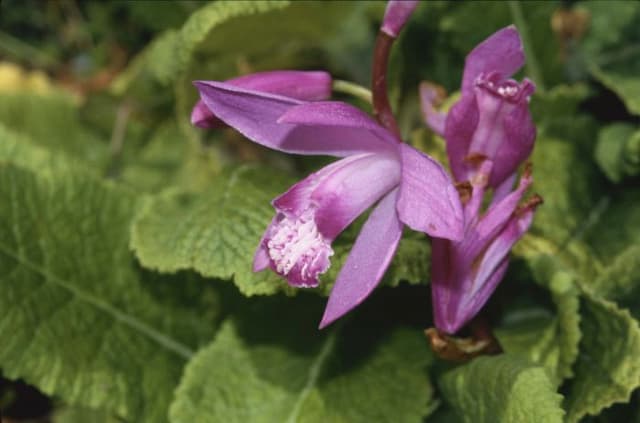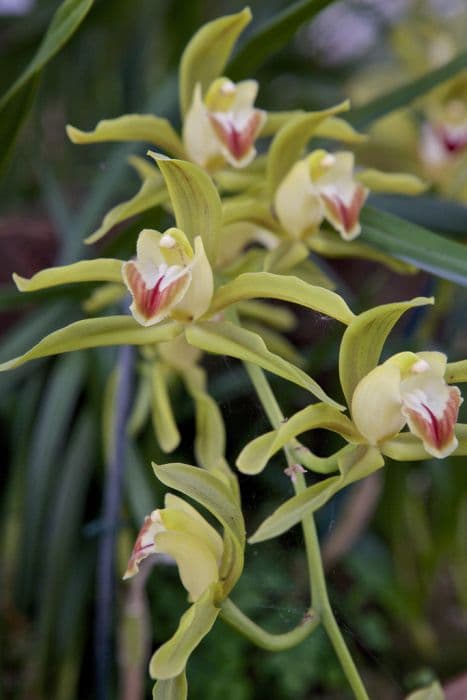Military Orchid Orchis militaris






ABOUT
The military orchid, as it's commonly known, is a distinctive and charming plant recognized for its complex and attractive flower structure. The flower spike is densely packed with individual blooms that somewhat resemble little soldiers, hence the name. Each flower boasts a hood-like upper petal that arches elegantly above a lip petal intricately patterned with pink and lilac coloration, often with small spots and a distinctive three-lobed appearance. Below the hooded petal, two long, twisted petals stretch outwards, adding to the orchid’s intricate display. The color palette of the military orchid is generally a mix of soft and striking hues. The primary colors include pinks, purples, and sometimes white with shades varying from pale to more intense. The leaves of the military orchid are a lush green, typically forming a rosette at the base of the plant. These leaves are lance-shaped, somewhat glossy, and can have spotted or unmarked patterns. As the season progresses, the leaves at the base may wilt, while the stalk continues upward, lingering on after the flowers have faded. The whole plant typically exudes an aura of elegance and intricacy that makes it a favorite among orchid enthusiasts and a fascinating specimen for nature lovers.
About this plant
 Names
NamesFamily
Orchidaceae
Synonyms
Military Orchid, Soldier Orchid
Common names
Orchis militaris L., Orchis guibertiana Gand., Orchis gaudiniana Leresche, Orchis logisii Leresche, Orchis intacta Lam., Orchis undulatifolia Stokes, Orchis caspia Steven, Orchis taurica Steven, Orchis contracta Steven, Satyrium militare (L.) Pers., Loroglossum militare (L.) Rich., Orchis militaris var. stevenii A.Kern.
 Toxicity
ToxicityTo humans
Military Orchid (Orchis militaris) is not known to be toxic to humans. Therefore, if ingested, it is not expected to cause any significant or toxic symptoms.
To pets
Military Orchid (Orchis militaris) is also not recognized as a toxic plant to pets. If pets ingest this plant, they are unlikely to experience poisoning or serious health consequences. However, it’s generally advisable to prevent pets from eating plants as even non-toxic plants can cause mild stomach upset if ingested.
 Characteristics
CharacteristicsLife cycle
Perennials
Foliage type
Deciduous
Color of leaves
Green
Flower color
Pink
Height
1-2 feet (30-60 cm)
Spread
0.5-1 feet (15-30 cm)
Plant type
Herb
Hardiness zones
5
Native area
Europe
Benefits
 General Benefits
General Benefits- Attracts Pollinators: Orchis militaris serves as a source of nectar for bees and other pollinating insects, supporting local ecosystems.
- Biodiversity Support: As part of its natural habitat, it contributes to the biodiversity of the area by providing various ecological functions.
- Landscape Beautification: With its striking flowers, the plant adds aesthetic value to natural landscapes and garden settings.
- Educational Interest: Orchis militaris is often used in educational settings to teach about plant reproduction and the importance of conserving wildflower species.
- Ecotourism Attraction: The presence of this charismatic plant can enhance ecotourism, with people visiting natural habitats to view it and other wildflowers in bloom.
- Scientific Research: It offers opportunities for scientific study regarding plant ecology, conservation, and the impacts of environmental change on delicate species.
- Cultural Significance: In some areas, the plant holds traditional or cultural importance that can be integral to local communities and their sense of place.
- Genetic Diversity: As part of a diverse plant community, it contributes genetic variability that can be crucial for the resilience of ecosystems.
 Medical Properties
Medical Properties- Orchis militaris, commonly known as Military Orchid, has been used in traditional medicine, primarily in European folk medicine.
- The tubers are considered nutritive and have been used as a source of starch called 'Salep', which was believed to be strengthening and nutritive, especially for children.
- It has been used traditionally as an antidiarrheal agent due to its possible astringent properties.
- Its demulcent properties, due to the mucilage from the tubers, were used for soothing the digestive tract.
- Some historical references mention its use as an aphrodisiac, but this is not supported by scientific evidence.
 Air-purifying Qualities
Air-purifying QualitiesThis plant is not specifically known for air purifying qualities.
 Other Uses
Other Uses- Orchis militaris, commonly known as military orchid, can be used as a natural indicator of ecological health of the habitat as its presence implies a well-preserved environment.
- The root of the military orchid, when dried and powdered, was once used as an ingredient in baking certain European bread and pastries as a flavor enhancer.
- Due to its striking appearance, the military orchid is used in ornamental horticulture to create visually appealing landscapes and gardens.
- The military orchid has been featured in folklore and myth, often being associated with fertility and virility due to its phallic-shaped tubers.
- It serves as an educational tool in botanical studies and conservation biology to illustrate symbiotic relationships with specific pollinators and the importance of habitat preservation.
- In art and photography, the distinctive shape and color of military orchid flowers make them a popular subject for botanical illustrators and nature photographers.
- The flower can be a useful component in the creation of wildflower meadows which aim to boost biodiversity and provide habitats for pollinators.
- Military orchid plays a role in local cultural heritage and traditions where it is native, often being celebrated in flower festivals and regional emblems.
- Eco-tourism activities, such as guided walks in nature preserves, often feature military orchid sightings as a highlight for plant enthusiasts and nature lovers.
- Its unique shape and coloration are used in the design industry for patterns and motifs in textiles, wallpaper, and other decorative elements.
Interesting Facts
 Feng Shui
Feng ShuiThe Military Orchid is not used in Feng Shui practice.
 Zodiac Sign Compitability
Zodiac Sign CompitabilityThe Military Orchid is not used in astrology practice.
 Plant Symbolism
Plant Symbolism- Beauty and Refinement: Orchis militaris, commonly known as Military Orchid, is often associated with beauty and refinement due to its elegant and intricate flowers.
- Strength and Power: The name 'Military Orchid' suggests an association with strength and power, as it carries connotations of the military.
- Fertility and Virility: In traditional symbolism, orchids are often linked to fertility and virility, reflecting their historical use in love potions and aphrodisiacs.
- Rarity and Preciousness: Military Orchid is rare in the wild, symbolizing something precious and valued, which must be protected.
 Water
WaterThe Military Orchid should be watered thoroughly but infrequently, allowing the soil to dry out slightly between waterings. During the active growth period in spring and early summer, you may need to water once every week, providing about 1 gallon of water each time, depending on the size of the plant and the environmental conditions. During the dormant period in late summer to early fall, reduce watering to once every two to three weeks. Overwatering can lead to root rot, so ensure proper drainage to prevent standing water.
 Light
LightThe Military Orchid thrives in bright, indirect sunlight. It should be placed in a spot where it can receive ample light without direct exposure to harsh midday sun, such as a north-facing or east-facing window. This plant can also adapt to dappled sunlight, similar to its natural woodland habitat, making it versatile in various lighting conditions.
 Temperature
TemperatureThe Military Orchid prefers temperate conditions and will thrive in an environment where temperatures are between 50°F and 75°F. It is important to protect the plant from extreme temperature changes; it can survive minimum temperatures down to about 40°F and maximum temperatures up to about 85°F. The ideal temperature range for the Military Orchid is within the moderate to cool range, mimicking its natural cool woodland habitat.
 Pruning
PruningPruning is not generally required for the Military Orchid as it does not have significant dead or overgrown foliage to manage. Remove any damaged or dead leaves or stems as you notice them to keep the plant healthy and prevent disease. The best time for this light pruning is after the plant has finished flowering, typically in the late summer or early fall.
 Cleaning
CleaningAs needed
 Soil
SoilThe Military Orchid thrives best in a soil mix that mimics its natural limestone grassland habitat, which is well-draining and rich in organic matter. A mixture of loam, chalk, and leaf mold or decomposed pine bark is often recommended. The ideal pH for this orchid's soil should be slightly alkaline, ranging from 7.5 to 8.5.
 Repotting
RepottingThe Military Orchid does not require frequent repotting and can generally be repotted every second year or when the potting medium starts to deteriorate. Care should be taken to minimize root disturbance.
 Humidity & Misting
Humidity & MistingThe Military Orchid prefers high humidity levels, usually around 70-80%. It's important to maintain consistent humidity without overwatering the plant.
 Suitable locations
Suitable locationsIndoor
Use bright, indirect light and ensure high humidity.
Outdoor
Plant in dappled sunlight, protect from strong winds.
Hardiness zone
5-9 USDA
 Life cycle
Life cycleOrchis militaris, commonly known as the Military Orchid, begins its life as a seed that germinates in symbiosis with a mycorrhizal fungus essential for its growth, as it lacks sufficient endosperm to sustain the seedling on its own. Once germinated, the plant grows into a rosette of leaves close to the ground, where it can perform photosynthesis and store energy in its tuberous root. This vegetative phase may last for several years before the plant reaches maturity. Upon maturity, the Military Orchid sends up a floral spike bearing numerous intricate, pink to purplish flowers that mimic the appearance of a soldier in uniform, which bloom in late spring to early summer. After pollination by insects attracted to the flowers, the plant develops seed capsules which split open when ripe to release thousands of dust-like seeds to the wind. Post-reproduction, the above-ground parts of the orchid wither, but the plant can survive underground through its tuber, allowing it to re-emerge and complete the cycle in subsequent years.
 Propogation
PropogationPropogation time
Spring to early summer
The most popular method of propagation for the Military Orchid (Orchis militaris) is through seed sowing. This method is typically done in the fall after the seed capsules have matured and opened. To propagate by seed, the tiny dust-like seeds are scattered on the surface of a specialized orchid-growing medium that contains a symbiotic fungus essential for germination. This medium provides the necessary nutrients and allows the essential mycorrhizal relationship to develop, which is critical for the seeds to germinate and the young orchids to grow. Care should be taken to maintain high humidity and steady temperatures, avoiding direct sunlight, to create an environment conducive to growth. Seedling development is slow, and it may take several years for the orchids to reach flowering size.








